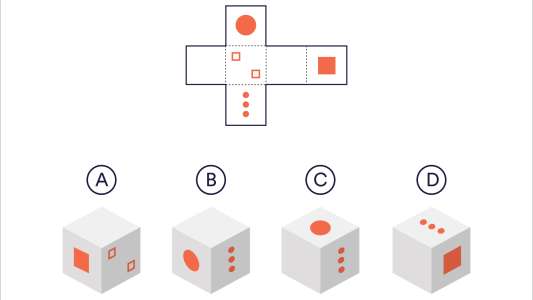Spatial reasoning tests are aptitude tests that require candidates to draw conclusions about shapes based on limited information.
Questions are object-based and to answer correctly you will need to visualise movement, find patterns and use logic to find the right picture.
These tests can be described as spatial reasoning tests or spatial awareness tests, and are largely used as part of the recruitment process for technical and engineering roles.
Spatial reasoning questions will often focus on:
- Shape matching
- Rotation of shapes
- Mirror images
- Block counting
- Maps
- Cube views
- Combining 2D shapes
Spatial awareness tests are challenging. Although they don’t require any previous knowledge, the unfamiliar structure of the questions, the imagination needed to mentally manipulate the images, and the logic to find the answers without all the information is hard.
Learning more about the tests themselves and using these tips for success will help you make the most of your assessment experience and ace the spatial test when it counts.
Step 1: Identify the publisher
Not all spatial awareness tests are created equal. Different publishers create assessments that are used in various industries – so if you can discover who is publishing your test you can get a headstart on preparation.
Speak to the recruiter if the information is not provided in your application pack.
Step 2: Work on your weaknesses
In a spatial awareness test, you are likely to find certain types of questions harder to answer correctly. You might find that you struggle to visualise 3D shapes, or that answering enough questions in the time limit is the problem. These weaker areas should be the focus of your practice.
Step 3: Give yourself the best chance
As most spatial reasoning tests are taken online, the likelihood is that you will be completing yours at home. To make sure that you are prepared, have a good night’s sleep and set yourself up with a decent breakfast. Stay hydrated too.
Wherever you are taking the test, be sure it is somewhere quiet where you won’t be disturbed. Ensure that you have a reliable internet connection.
Step 4: Practice
Although there is no previous knowledge required when taking spatial tests, practicing them does make you better. If you have discovered the publisher (see Step 1), you can find practice tests based on their structure and time limits.
Step 5: Read the instructions
Although you might think that you know what you are doing after practice tests, it is always a good idea to carefully read the instructions in the real test. They might suggest a different way to record your answers, or provide other important information.
In some tests, there might be a practice question to try beforehand. Always spend a few moments answering this, to get yourself into the right frame of mind for completing the test.
Step 6: Structure your time
Try not to rush. Divide the whole time alloted by the number of questions, and you will get an idea of how long you have for each question.
The practice you do will help you recognise patterns, look for rules, and get to the answer – if you take enough time to fully read and understand the question.
Step 7: Understand what the question is asking for
Before you look at the answers, consider what the question is asking. This means taking some time to examine the given shapes or images, and imagining what the answers might be.
For example, if the question is asking you to find the mirrored image, you might want to picture the mirrored image first.
Step 8: Rule out definite wrong answers
The benefit of a multiple-choice answer is that there are likely to be obviously wrong answers that you can rule out immediately.
One of the easiest ways is to manipulate the image in the way the question is answering before looking at the answers, and then compare them.
Step 9: Develop your spatial skills
Try drawing things in 3D, doing jigsaws, rotating shapes in front of the mirror, or assembling complex model kits using plans. These are all ways to train your brain at spatial awareness. Ultimately you can improve your spatial reasoning skills with practice
Step 10: Check over your answers
Hopefully you will have a little time left over at the end. You can use this to check through the test and make sure that you have answered all the questions, or go back to the questions you found tricky and spend a bit more time on answering them.


